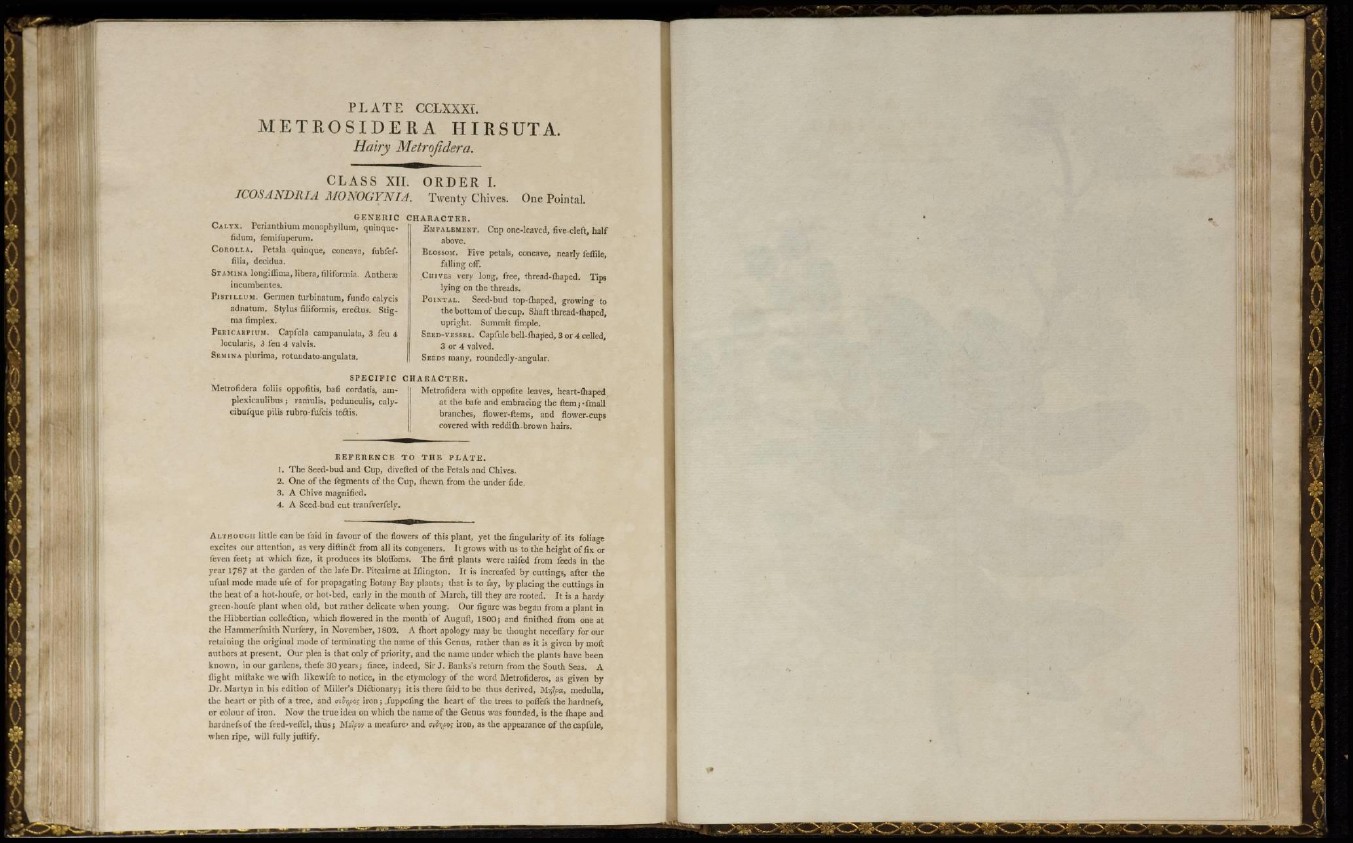
M E T R O S I D E RA HIRSUTA.
Hairy Metroßdera.
CLASS XII.
ICOS A NDRI A MONOGYNIA.
G E N E R I C
C A L Y X . Peña l i t h i um monnphyllum, quinqucfidum,
iemiiuperum.
C O R O L L A . Pétala quinqué, concava, fubfcffilia,
decidua.
S T A M I N A longillima, libera, liliforniia. Anthcrx
incumben te».
P I S T I L L U M . Germen turbinatum, fundo calycis
a d n a t u m . Stylus filifonnis, ercéius. Stigma
limplex.
P E H I C A R P I U M . Capfula campanulata, 3 feu 4
Iccularis, 3 feu 4 valvis.
S E M I N A plurima, rotm.dato-pngulata.
ORDER I.
Twenty Chives. One Pointal.
H A R A C T E H .
F . M F A L B N E N T . Cup one-leaved, five-cleft, half
above.
BLOSSOM. Five petals, concave, nearly fertile,
t a i l i n g off.
C H I V E S very long, free, thread-ibaped. Tip*
l y i n g on t h e threads.
P O I N T A L . Seed-bud top-fliaped, growing to
the b o t t om o f t h e c u p . Shaft thread-ihaped,
upright. Summit fimple.
SEED-VESSEL. Copfule bell-fnap'ed, 3 or 4 celled,
3 o r 4 valved.
SEEDS many, roundedly-angular.
S P E C I F I C C H A R A C T E
Melroíidera foliis oppofitis, bafi cordatis, a m -
plexicaulibus ; ramulis, pedunculis, calycibnfque
pilis rubro-fufcis tectis.
Metrofidera with oppofite leaves, heart-fliaped
at the bafe and embracing the ftemj-fmall
branches, flower-items, and flower-cups
covered w i t h reddilh-brown hairs.
R E F E R E N C E T O T H E P L A T E .
. T h e Seed-bud and C u p , diverted of t h e Petals and Chives.
. O n e of t h e fegments of t h e C u p , fliewn from the u n d e r fide.
. A C h i v e magnified.
. A Seed-bud c u t traufveriely.
A L T H O U G H little can b e laid in favour of t h e flowers of this plant, yet t h e Angularity of its foliage
excites our a t t e n t i o n , as very diflinct from all i ts congeners. It grows with us t o t h e height of fix or
("even feet; at which iize, it produces its bloffoms. The firfl plants were raifed from feeds in t h e
year 1 ? 8 7 at t h e garden of the l a t e Dr. Phcairne at I l l i n g t o n . It is incrcafed by c u t t i n g s , after t he
ufual mode made ufe o f for p r o p a g a t i n g Botany Bay p l a n t s ; that is to fay, by p l a c i n g t h e c u t t i n g s in
t h e heat of a hot-houfe, or hot-bed, early in the m o n t h of March, till they a r e rooted. It is a hardy
grecn-houl'c plant when old, but r a t h e r delicate when young. Our figure was began from a p l a n t in
the H i b b c r t i a n collection, which flowered in t h e month of Auguft, 1 8 0 0 ; a n d finilhed from one at
the Hammerfmith Nurfery, in November, 1 8 0 2 . A lhort apology may be thought ncccflary for o u r
r e t a i n i n g t h e original mode of t e r m i n a t i n g the name of this Genus, rather than as it is given by moll
authors at p t e s e n t . Our plea is that only of p r i o r i t y , and t h e n a m e under which t h e p l a n t s have been
known, in o u r g a r d e n s , thefe 3 0 y e a r s ; nnce, indeed. Sir J . Banks' s r e t u r n from the Soutli Seas. A
flight mitlake we wifli likewife to notice, in the etymology of the word Metrofideros, as given by
D r . M a r t y n in his edition of Miller's Dictionary; it is t h e r e faid to b e thus derived, Mrppa, medulla,
t h e heart or pith of a t r e e , and o-iJijfSj i r o n ; fuppofing the heart of the trees to poflcl's the hardnefs,
or colour of i r o n . Now t h e t r u e idea on which t h e n a m e of t h e Genus was founded, is t h e fliape a nd
hardnefs of t h e feed-veffel, t h u s ; ttAim a m e a f i i r c and triSrjo; iron, as t h e appearance of thecapfuJe,
when r i p e , will fully jultify.